Discover 35 hidden attractions, cool sights, and unusual things to do in Uppsala (Sweden). Don't miss out on these must-see attractions: Gamla Uppsala, Uppsala Castle, and Church of Sweden. Also, be sure to include Uppsala Cathedral in your itinerary.
Below, you can find the list of the most amazing places you should visit in Uppsala (Uppsala).
Table of Contents
Gamla Uppsala
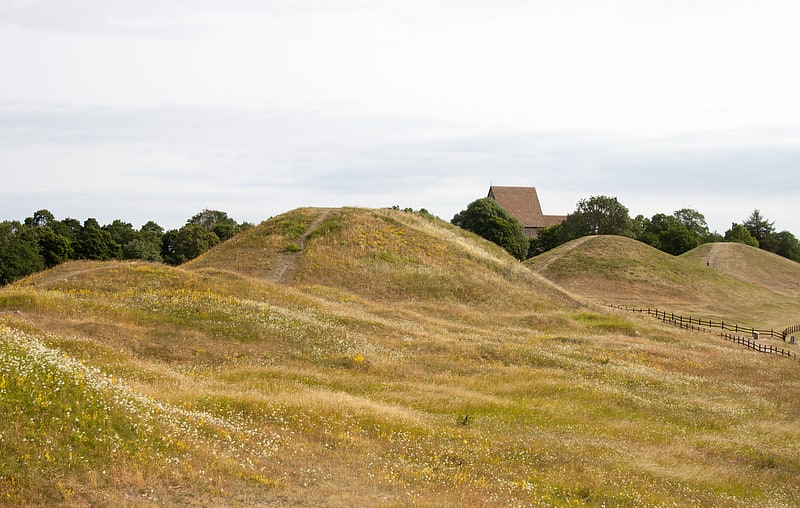
Village in Sweden. Gamla Uppsala is a parish and a village outside Uppsala in Sweden. It had 17,973 inhabitants in 2016.
As early as the 3rd century AD and the 4th century AD and onwards, it was an important religious, economic and political centre. Early written sources show that already during prehistory, Gamla Uppsala was widely famous in Northern Europe as the residence of Swedish kings of the legendary Yngling dynasty. In fact, the oldest Scandinavian sources, such as Ynglingatal, the Westrogothic law and the Gutasaga talk of the King of the Swedes (Suiones) as the "King at Uppsala". It was the main centre of the Swedes.
During the Middle Ages, it was the largest village of Uppland, the eastern part of which probably originally formed the core of the complex of properties belonging to the Swedish Crown, the so-called Uppsala öd, of which the western part consisted of the royal estate itself, kungsgården.
It was also the location of the Thing of all Swedes which was a thing (general assembly) held from prehistoric times to the Middle Ages, at the end of February or early March. It was held in conjunction with a great fair called Disting, and a Norse religious celebration called Dísablót. The Law of Uppland says that it was at this assembly that the king proclaimed that the fleet levy would be summoned for warfare during the summer, and all the crews, rowers, commanders and ships were decided.
It was not only the Norse cultic centre, it also became Sweden's archbishopric in 1164.[1]
Uppsala Castle
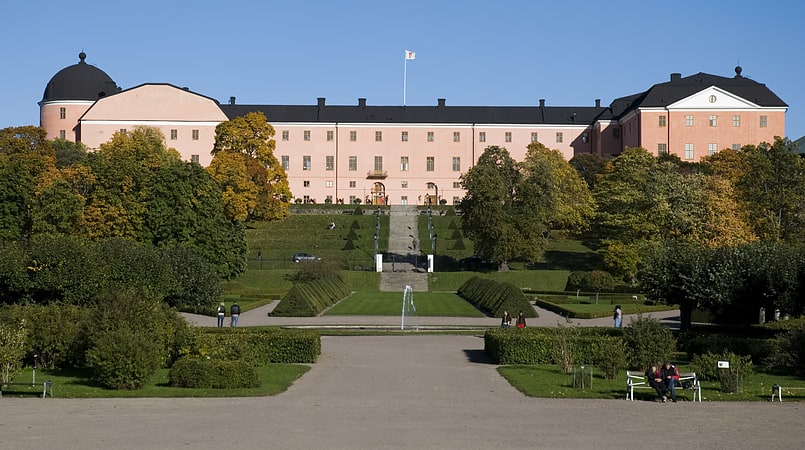
Also known as: Uppsala slott
Castle built by Gustav Vasa in 1549. Uppsala Castle is a 16th-century royal castle in the city of Uppsala, Sweden. Throughout much of its early existence, the castle played a major role in the history of Sweden. Originally constructed in 1549, the castle has been heavily remodeled, expanded, and otherwise modified. Today the structure houses the official residence of the governor of Uppsala County, various businesses, and two museums.[2]
Address: 2 Kung Jans Vaeg, 752 37 Uppsala
Church of Sweden
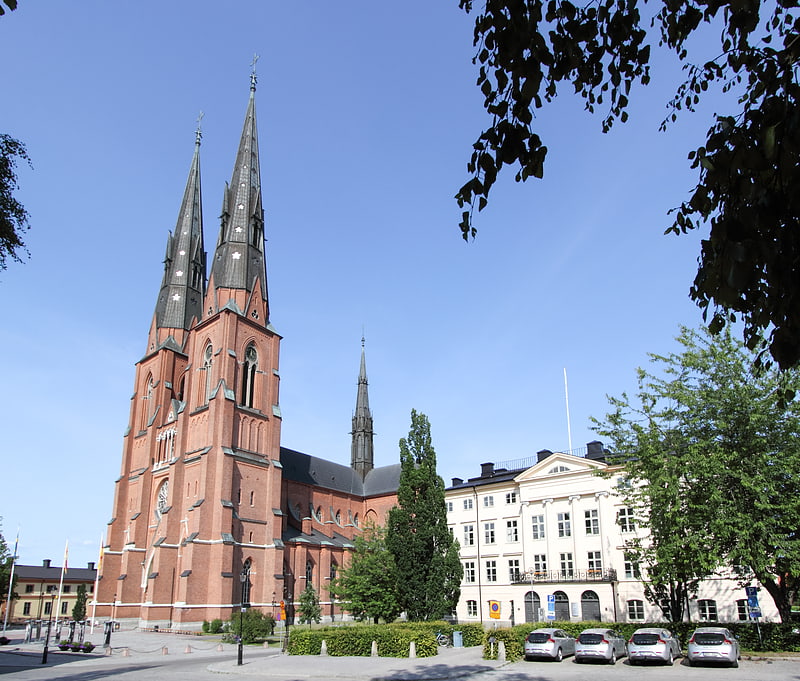
The Church of Sweden is an Evangelical Lutheran national church in Sweden. A former state church, headquartered in Uppsala, with just under 5.8 million members at year end 2020, it is the largest Christian denomination in Sweden, the largest Lutheran denomination in Europe and the third-largest in the world, after the Ethiopian Evangelical Church Mekane Yesus and the Evangelical Lutheran Church in Tanzania.
A member of the Porvoo Communion, the church professes the Lutheran branch of Christianity. It is composed of thirteen dioceses, divided into parishes. It is an open national church which, working with a democratic organisation and through the ministry of the church, covers the whole nation. The Primate of the Church of Sweden, as well as the Metropolitan of all Sweden, is the Archbishop of Uppsala — currently Antje Jackelén, Sweden's first female archbishop. Today, the Church of Sweden is an Evangelical Lutheran church.
It is liturgically and theologically "high church", having retained priests, vestments, and the Mass during the Swedish Reformation. In common with other Evangelical Lutheran churches (particularly in the Nordic and Baltic states), the Church of Sweden maintains the historical episcopate and claims apostolic succession. Some Lutheran churches have congregational polity or modified episcopal polity without apostolic succession, but the historic episcopate was maintained in Sweden and some of the other Lutheran churches of the Porvoo Communion. The canons of the Church of Sweden states that the faith, confession and teachings of the Church of Sweden are understood as an expression of the catholic christian faith. It further states that this does not serve to create a new, confessionally peculiar interpretation, but concerns the apostolic faith as carried down through the traditions of the church, a concept similar to the doctrine of "reformed and catholic" found within the Anglican Communion.
When Eva Brunne was consecrated as Bishop of Stockholm in 2009, she became the first openly lesbian bishop in the world.
Despite a significant yearly loss of members (lately 1-2% annually), its membership of 5,728,748 people accounts for 55,2 % (yearend 2020) of the Swedish population. Until 2000 it held the position of state church. The high membership numbers arise because, until 1996, all newborn children were made members, unless their parents had actively cancelled their membership. Approximately 2% of the church's members regularly attend Sunday services. According to a Gallup poll conducted in 2009, 17% of the Swedish population considered religion as an important part of their daily life.[3]
Address: Visiting address: S:t Eriks torg 7, Uppsala
Uppsala Cathedral
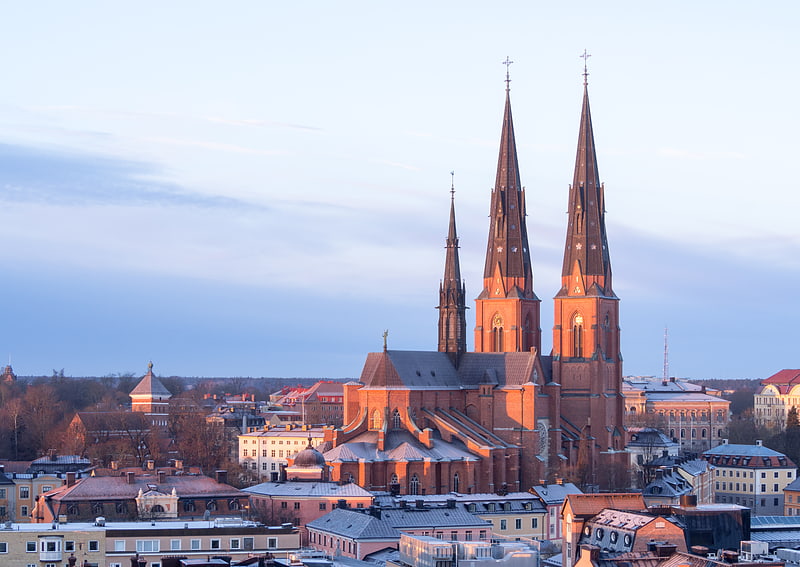
Also known as: Uppsala domkyrka
Iconic Gothic landmark with royal tombs. Uppsala Cathedral is a cathedral located between the University Hall of Uppsala University and the Fyris river in the centre of Uppsala, Sweden. A church of the Church of Sweden, the national church, in the Lutheran tradition, Uppsala Cathedral is the seat of the Archbishop of Uppsala, the primate of Sweden. It is also the burial site of King Eric IX, who became the patron saint of the nation, and it was the traditional location for the coronation of new Kings of Sweden.
The current archbishop is Antje Jackelén and the current bishop is Karin Johannesson.
The cathedral dates to the late 13th century and, at a height of 118.7 metres, it is the tallest church in the Nordic countries. Originally built under Roman Catholicism, it was used for coronations of Swedish monarchs for a lengthy period following the Protestant Reformation. Several of its chapels were converted to house the tombs of Swedish monarchs, including Gustav Vasa and John III. Carl Linnaeus, Olaus Rudbeck, Emanuel Swedenborg, and several archbishops are also buried here.
The church was designed in the French Gothic style by French architects including Étienne de Bonneuil. It is in the form of a cross formed by the nave and transept. Most of the structure was built between 1272 and 1420 but the western end was completed only in the middle of the 15th century. Twin towers were built shortly afterwards on the west end of the church. High spires were added later, but after a fire in 1702, they were adorned with low helms by Carl Hårleman in 1735. They were completely redesigned by Helgo Zetterwall who undertook substantial changes to the building in the 1880s. The cathedral's principal construction material is brick but the pillars and many details are of Gotland limestone.
The vaults were all built according to the original 13th-century plan although some of them were erected as late as around 1440. In addition to the artwork in the funeral chapels, several of the church's older furnishings can be seen in the Treasury Museum. In 1702, many features were destroyed in a major fire. During the renovation work carried out in the 1970s, many of the medieval frescoes which had been whitewashed over after the Reformation were uncovered and restored.[4]
Address: Domkyrkoplan 2, 753 10 Uppsala
Fyrishov

Arena in Uppsala, Sweden. Fyrishov is the largest arena in Uppsala and is Sweden's fourth most visited, specialized in swimming, sports events, meetings and recreation. The facility includes areas for indoor sports, summer sport and a generous waterpark with waterslides, 50-meter pool, training pool, relaxation area and a large outdoor swimming pool. Accommodation is offered at Fyrishov cabin area and at the resort restaurants, a good lunch or dinner can be enjoyed. Fyrishov AB's business also includes the operation of Gottsundabadet in which there is a 25-meter pool, a 10-meter children's pool and gym. The entire facility is open all year round and a large number of meetings and various events are held here annually.
In addition to activities within the arena Fyrishov AB runs Tävlingsstaden Uppsala in a collaboration between the sports organizers, Fyrishov AB, Uppsala, Uppsala Tourism and hotel business. Co-founded in 2006 by Fyrishov AB under the name SM-town Uppsala (SM stands for Svenska mästerskap, i.e. Swedish national championships) in 2007 but was expanded to include international events and competitions at high national level. The project aims to develop Uppsala, a leading sports town in Sweden. Year 2009 there were 24 SM-competitions and major national and international competitions in Uppsala.
At Fyrishov the city's basketball team Uppsala Basket also plays, former KFUM Uppsala, their home games in the Swedish basketball league. There are also athletic club Uppsala, the fencing club Upsala Fäktning, Uppsala Judo Club, Sweden's oldest judo club, Uppsala volleyball companion, Upsala weightlifting club and Upsala Simsällskap, one of the world's oldest swimmingclubs. The sport that draws the most audience is floorball. Uppsala's two teams in the Swedish Super League, Storvreta IBK and IK Sirius IBK, have Fyrishov as their home.[5]
Address: Idrottsgatan 2, 753 33 Uppsala
Upplandsmuseet
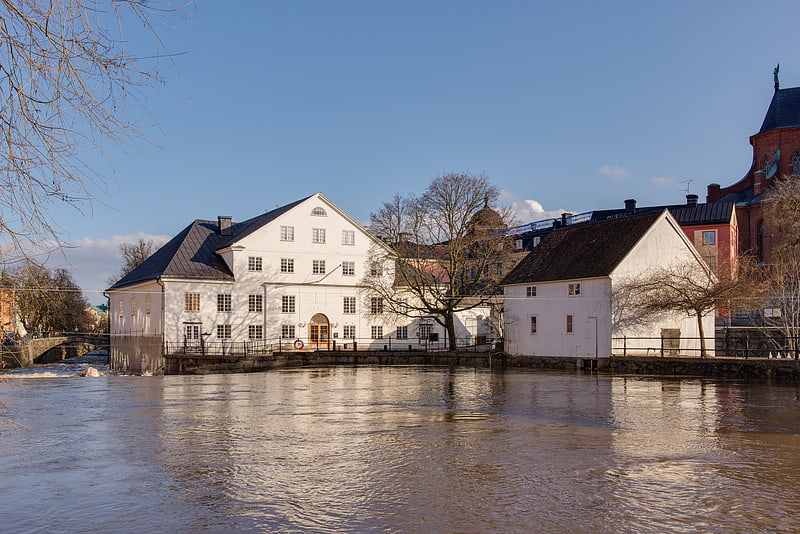
Museum in Uppsala, Sweden. Upplandsmuseet is the county museum of Uppsala County, Sweden.
The institution is responsible for preservation and conducting research in the area of the cultural history and archaeology of the county, including the city of Uppsala (parts of the historical province of Uppland, from which the museum takes its name, belong to Stockholm County). The permanent exhibition covers subjects such as the history of the city, of Uppsala Cathedral, and of student life at Uppsala University. Public activities are conducted in the Akademikvarnen, the open air museum Disagården in Gamla Uppsala and at Walmstedtska gården in the Karin district of Uppsala.
The museum is headquartered in the Akademikvarnen, a former water mill belonging to the university, located on the Fyris River in central Uppsala. The former water mill was completed in 1768. It remained in operation until 1946. Between 1957 and 1959 the mill's premises were rebuilt to house the Uppland Museum. The exterior of the building was used by Ingmar Bergman for the bishop's house in the film Fanny and Alexander (1982).[6]
Address: 10 S:T Eriks Torg, 753 10 Uppsala
Gustavianum
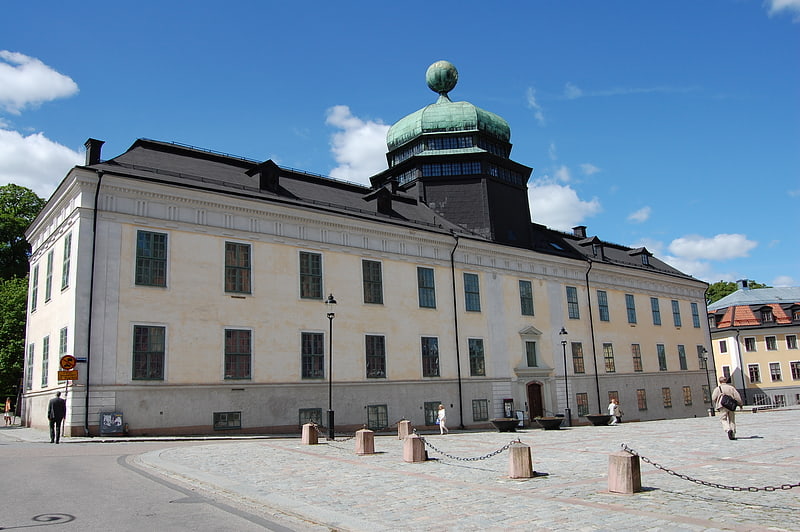
Museum with eclectic historical exhibits. Gustavianum is the oldest standing building of Uppsala University. It was built between 1622 and 1625, and used as the main building of the university between 1778 and 1887. Since 1997 it is used as the university museum of Uppsala University.[7]
Linnaean Garden
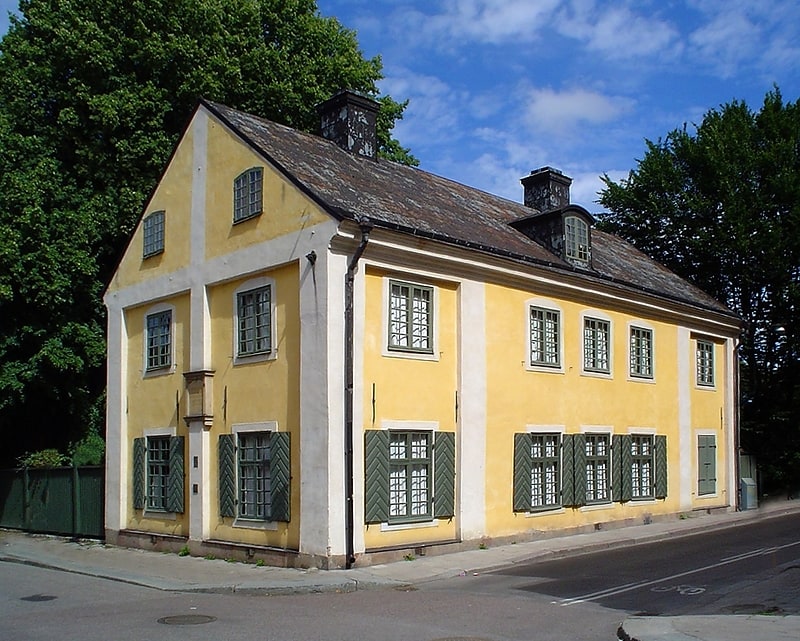
Also known as: Linnémuseet
Garden in Uppsala, Sweden. The Linnaean Garden or Linnaeus Garden is the oldest of the botanical gardens belonging to Uppsala University, Sweden, and nowadays one of two satellite gardens of the larger University of Uppsala Botanic Garden, the other being the Linnaeus family's former summer home Linnaeus's Hammarby. The garden has been restored and is kept as an 18th-century botanical garden, according to the specifications of Carl Linnaeus, who started studying at Uppsala University in 1730 where he later became professor of botany and principal and is known for formalising the modern system of naming organisms, creating the modern binomial nomenclature, and who owned the garden from 1741 and had it rearranged according to his own ideas, documented in his work Hortus Upsaliensis.
The garden was originally planned and planted by Olaus Rudbeck, professor of medicine, in 1655, and had about 1,800 different species in late 17th century, but was damaged in the 1702 Uppsala city fire. In 1693, Rudbeck also built the house adjacent to the garden, nowadays known as the Linnaeus Museum (Linnémuséet), which was residence of Linnaeus from 1743, and from his death in 1778 to 1934 residence of employees at Uppsala University, the last of whom was musician Hugo Alfvén. Since 1937, the house has been a museum of Linnaeus personal and professional life, with furniture, household items and textiles belonging to the Linnaeus family exhibited together with Linnaeus personal medicinal cabinet, insect cabinet and herbarium.
After the gardens of Uppsala Castle had been donated to the university by King Gustav III to serve as a new botanical garden, the old one was left to decay. It was bought by the Swedish Linnaean Society in 1917 and restored according to the detailed description in the Hortus Upsaliensis. The garden was later taken over by the university, while the Linnaeus Museum is still run by the Society.[8]
Botaniska trädgården
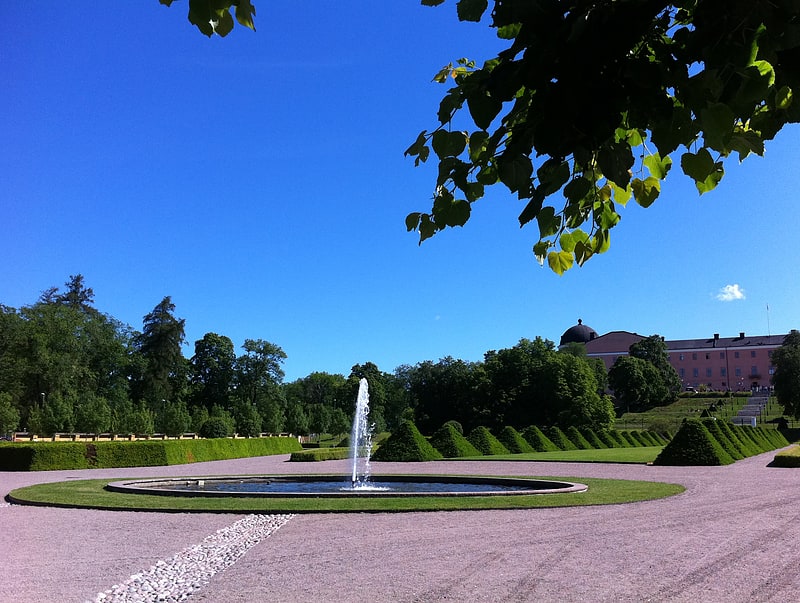
Botanical garden in Uppsala, Sweden. The University of Uppsala Botanical Garden, near Uppsala Castle, is the principal botanical garden belonging to Uppsala University. It was created on land donated to the university in 1787 by Sweden's King Gustav III, who also laid the cornerstone of Linneanum, its orangery.
Uppsala University also maintains two satellite botanical gardens. The older of these is its original botanical garden, created in 1655 by Olaus Rudbeck, now called the Linnaean Garden (in Swedish Linnéträdgården). The other satellite is Linnaeus Hammarby (Linnés Hammarby), the former summer home of Carl Linnaeus and his family.[9]
Address: Villavagen 8, 75236 Uppsala
Linnaeus' Hammarby
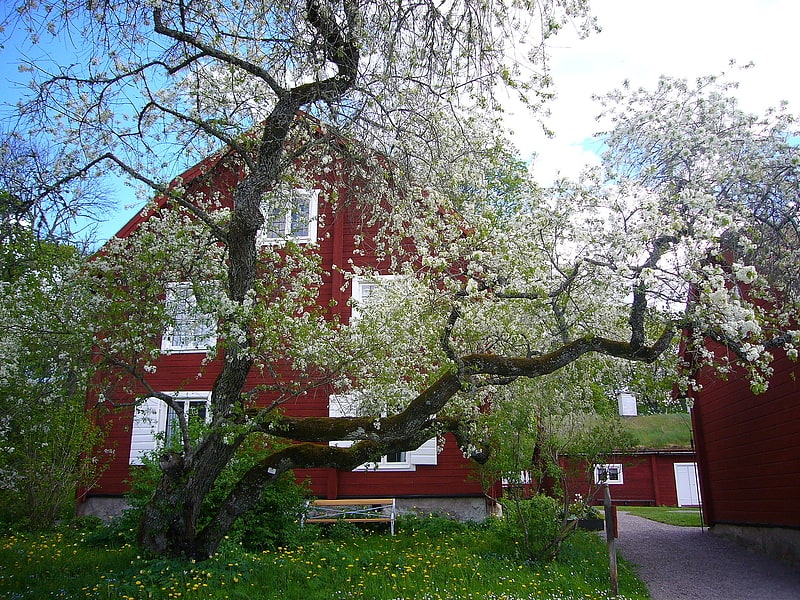
Also known as: Linnés Hammarby
Museum in Sweden. Linnaeus's Hammarby is a historic house museum and mansion, and one of three botanical gardens belonging to Uppsala University, located in Sweden. It is situated about 10 km south-east of Uppsala.[10]
Gamla Uppsala museum
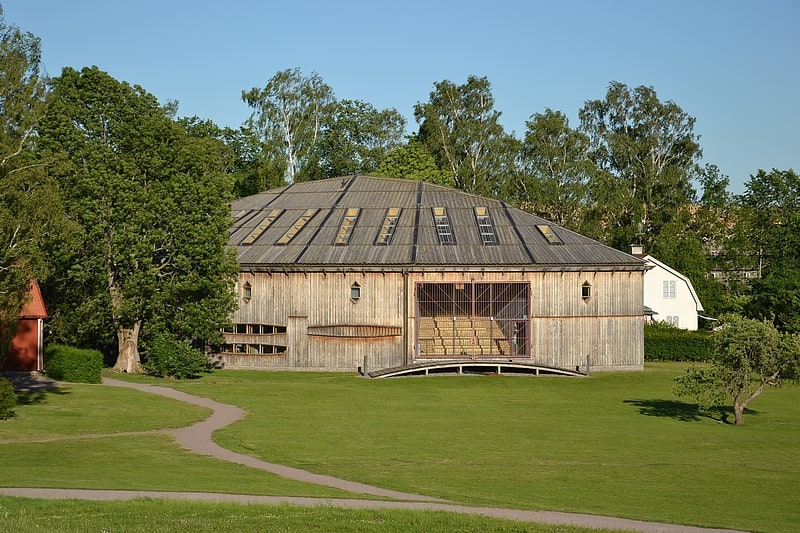
Museum in Uppsala, Sweden. Gamla Uppsala museum is a historical museum in Gamla Uppsala, in the northern part of Uppsala, Sweden.
The museum is oriented towards the Vendel and Viking era history of Gamla Uppsala. Gamla Uppsala was a major religious and cultural centre in Sweden during these eras as well as medieval Sweden between approximately the 5th and the 13th centuries, housing the famous pagan Temple at Uppsala and several large burial mounds. The museum building was designed by architect Carl Nyrén (1917– 2011). The museum opened in 2000 and is run by the Swedish National Heritage Board (Swedish:Riksantikvarieämbetet).[11]
Linnéträdgården
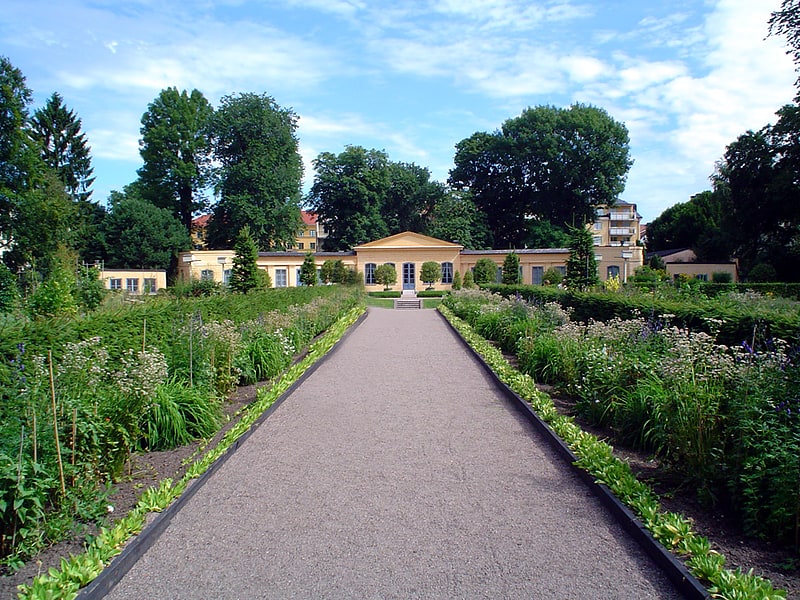
Country's oldest botanical garden. The Linnaean Garden or Linnaeus Garden is the oldest of the botanical gardens belonging to Uppsala University, Sweden, and nowadays one of two satellite gardens of the larger University of Uppsala Botanic Garden, the other being the Linnaeus family's former summer home Linnaeus's Hammarby. The garden has been restored and is kept as an 18th-century botanical garden, according to the specifications of Carl Linnaeus, who started studying at Uppsala University in 1730 where he later became professor of botany and principal and is known for formalising the modern system of naming organisms, creating the modern binomial nomenclature, and who owned the garden from 1741 and had it rearranged according to his own ideas, documented in his work Hortus Upsaliensis.
The garden was originally planned and planted by Olaus Rudbeck, professor of medicine, in 1655, and had about 1,800 different species in late 17th century, but was damaged in the 1702 Uppsala city fire. In 1693, Rudbeck also built the house adjacent to the garden, nowadays known as the Linnaeus Museum (Linnémuséet), which was residence of Linnaeus from 1743, and from his death in 1778 to 1934 residence of employees at Uppsala University, the last of whom was musician Hugo Alfvén. Since 1937, the house has been a museum of Linnaeus personal and professional life, with furniture, household items and textiles belonging to the Linnaeus family exhibited together with Linnaeus personal medicinal cabinet, insect cabinet and herbarium.
After the gardens of Uppsala Castle had been donated to the university by King Gustav III to serve as a new botanical garden, the old one was left to decay. It was bought by the Swedish Linnaean Society in 1917 and restored according to the detailed description in the Hortus Upsaliensis. The garden was later taken over by the university, while the Linnaeus Museum is still run by the Society.[12]
Address: 27 Svartbaecksgatan, 753 32 Uppsala
Uppsala Konsert & Kongress
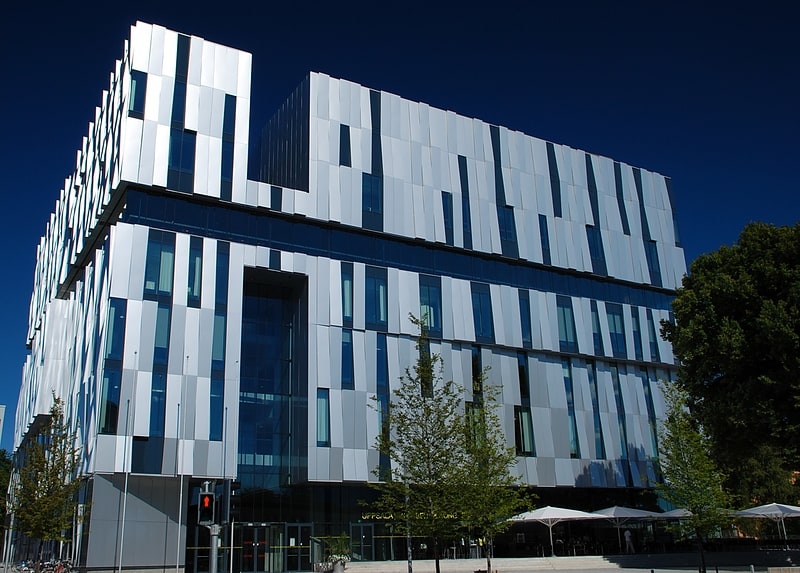
Uppsala Konsert & Kongress, popularly referred to as Musikens hus is a concert hall and convention centre in Uppsala, Sweden. The official inauguration of the building took place on Saturday, 1 September 2007.[13]
Address: 1 Vaksala Torg, 753 31 Uppsala
Archbishop's Palace
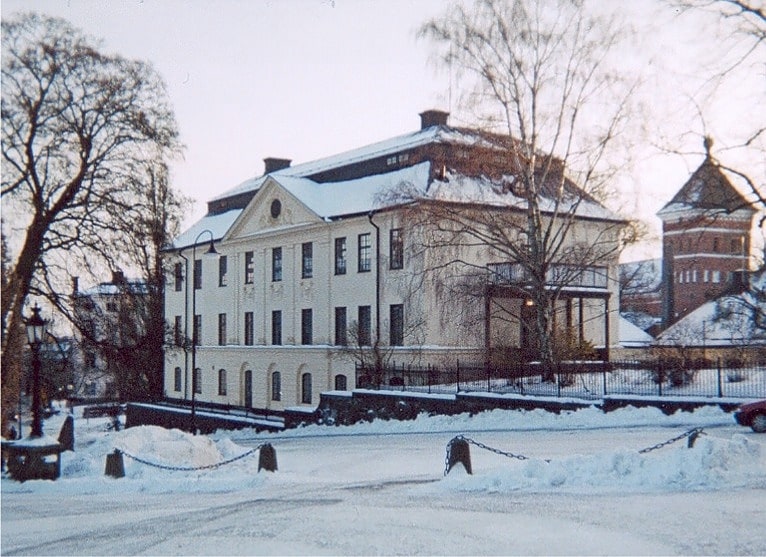
Also known as: Ärkebiskopsgården
The Archbishop's Palace in Uppsala, Sweden, is the official residence of the Lutheran Archbishop of Uppsala, the primate of the Church of Sweden. It was designed by Carl Hårleman and first completed in 1744, on or close to the site of several earlier buildings previously serving a similar role. The palace is situated facing the University Park, close to Uppsala Cathedral in the old city centre, west of the river.[14]
Salabacke Church
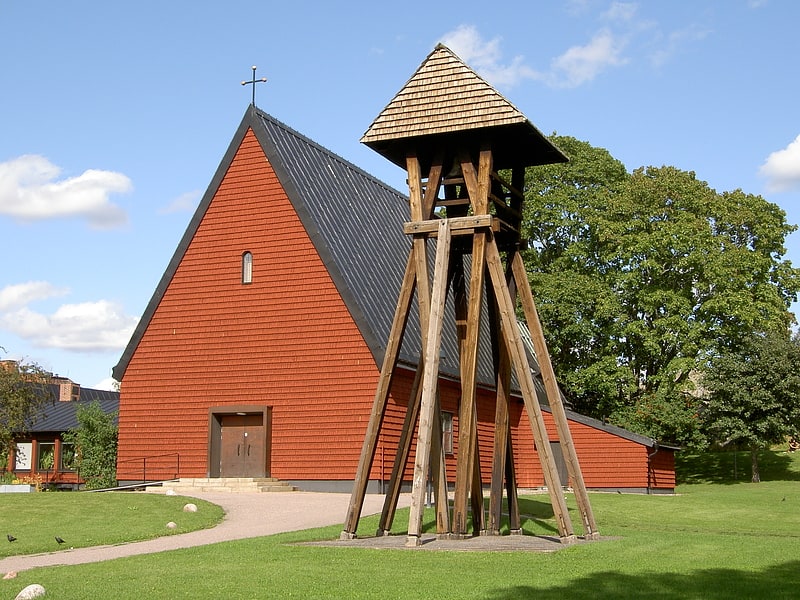
Also known as: Salabackekyrkan
Church in Uppsala, Sweden. Salabacke Church is a church in Sala backe, Uppsala, Sweden that was opened in 1958. The church was designed by Sten Hummel-Gumaelius and is made of wood. It suffered an arson attack in 1993 but was later rebuilt with an almost identical design.[15]
Address: Lästmakargatan 7B, 754 34 Uppsala
Bror Hjorths Hus
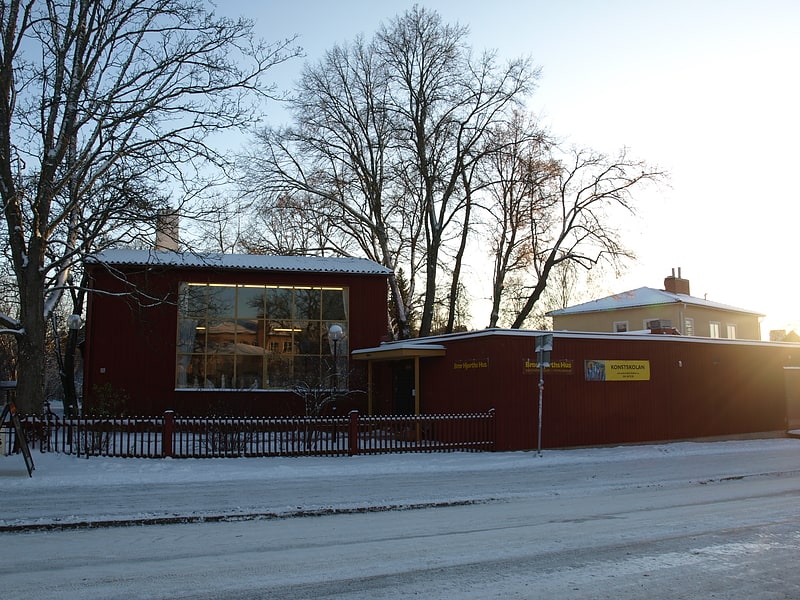
Museum in Uppsala, Sweden. Bror Hjorths Hus is a museum located in Uppsala, Sweden. The museum is housed in the former studio of sculptor and painter Bror Hjorth.
Hjorth's villa was designed by architect Sten Hummel-Gumaelius (1906-1986). The building was built in 1943 and was for 25 years both the home and studio of Bror Hjorth.
The museum has a large collection of Hjorth's work. The former residence and studio are filled with paintings, sculptures, reliefs and drawings as well as preliminary works and sketches for the artist's many public assignments. The museum opened in 1978. In the mid-1990s, the museum was expanded with an exhibition hall designed by architect Bengt Löfberg.[16]
Address: Norbyvägen 26, 752 39 Uppsala
Uppland Runic Inscription Fv1976 107

Also known as: Upplands runinskrifter Fv1976;107
This runic inscription, designated as U Fv1976;107 under the Rundata catalog, is located at the Uppsala Cathedral in Uppsala, Sweden.[17]
Geijersgården
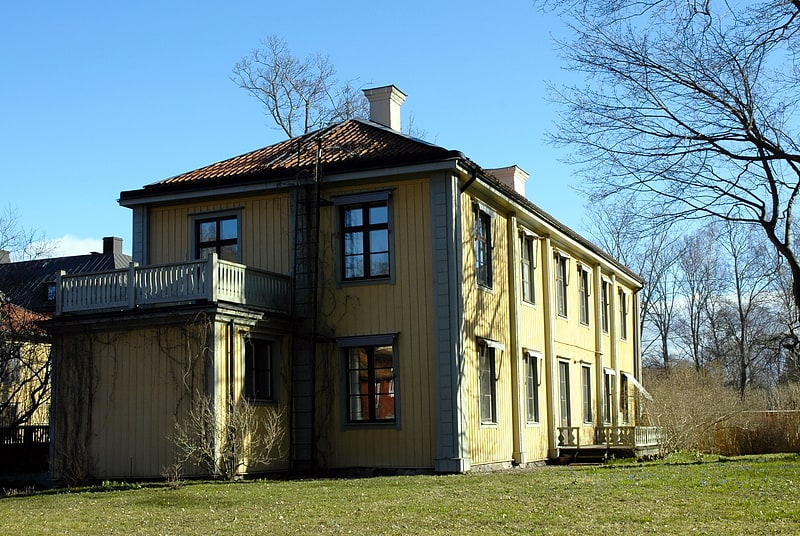
Geijersgården is located in Uppsala, Sweden, north of Carolina Rediviva, the main building of Uppsala University Library.
The name of the farm comes from Erik Gustaf Geijer who lived here 1837–46. The main building was built 1737–38 by governor Johan Brauner, whose son-in-law Johan Ihre lived there from 1739.
In 1837, Uppsala University wanted the farm buildings to be demolished in order to create a park by Carolina Rediviva. Then Geijer sold the southern part of the farm which contained a few small buildings, and had the remaining buildings renovated. The farm has its present appearance since 1850, when it was painted yellow; since 1850 it hasn't been changed.
In 1934 Uppsala University bought the farm.
In 1982 the west part of the main building burnt and the reparations were finished in 1983.[18]
Address: 2 Övre Slottsgatan, Uppsala
Vaksala kyrka
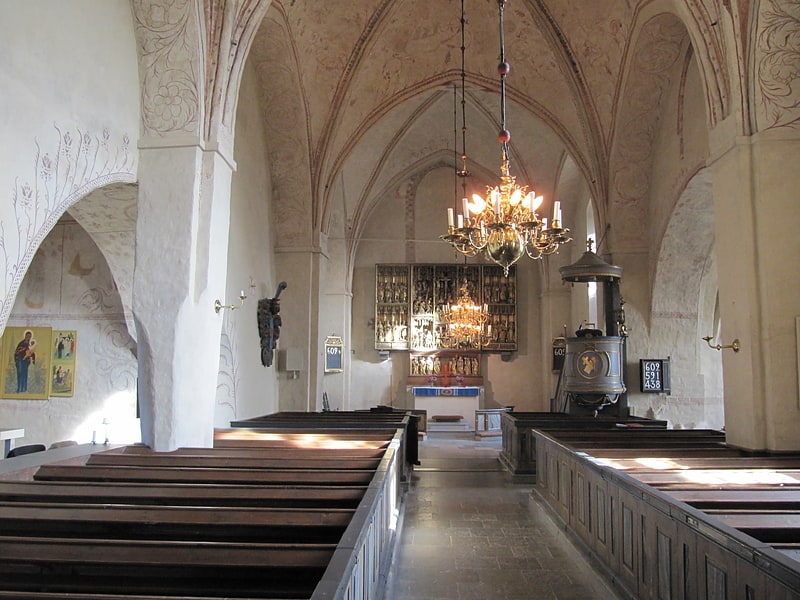
Church in Uppsala, Sweden. Vaksala Church is a medieval Lutheran church in the Archdiocese of Uppsala in Uppsala, Sweden. The church is considered one of the most unusual in the province of Uppland.[19]
Address: Vaksala kyrkväg 2, 754 45 Uppsala
Uppsala University Coin Cabinet

Also known as: Uppsala universitets myntkabinett
Building in Sweden. The Uppsala University Coin Cabinet is one of Sweden's most important public coin and medal collections. It is housed in the main building of Uppsala University.[20]
Address: 3 Biskopsgatan, 753 10 Uppsala
Evolutionsmuseet
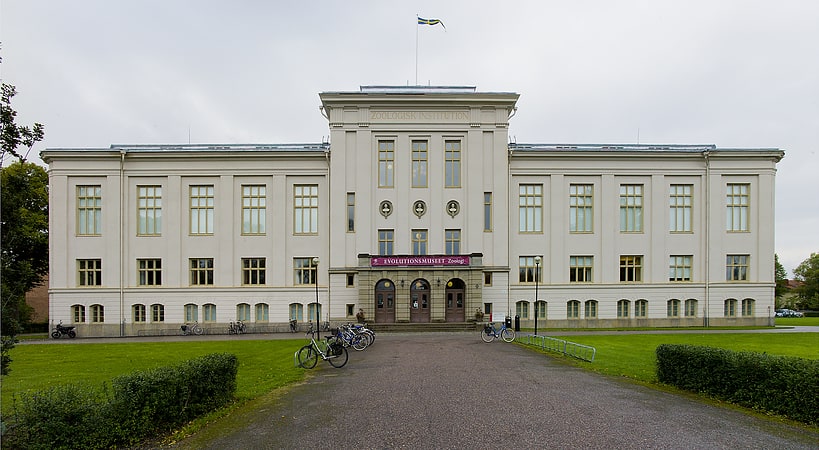
Museum in Uppsala, Sweden. The Museum of Evolution of Uppsala University is a natural history museum in Sweden containing the largest fossil collection in Scandinavia. The number of items in today's collection, which spans zoological, paleontological and mineralogical specimens, is approximately 5 million unique pieces, of which only a fraction are exhibited. Expeditions to China in the 20th century unearthed numerous unique paleontological treasures. The museum's collection contains three teeth of the Peking Man, found by paleontologist Otto Zdansky during an expedition to Zhoukoudian in 1921. Due to its large collection of type specimens the museum is an important establishment in the field of biological systematics, and it maintains an active exchange with other scientific institutions worldwide.[21]
Address: Villavägen 9, 752 36 Uppsala
Carolina Rediviva
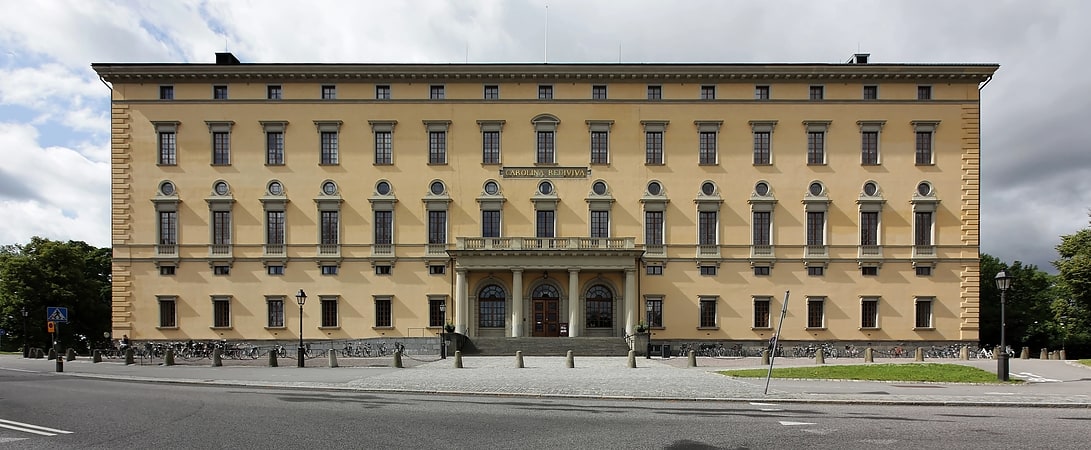
Carolina Rediviva is the main building of the Uppsala University Library in Uppsala, Sweden. The building was begun in 1820 and completed in 1841. The original architect was Carl Fredrik Sundvall. Later additions to the building have been designed by Axel Johan Anderberg and Peter Celsing. The name, literally "Carolina Revived", was given in remembrance of the old Academia Carolina building, which had functioned as the university library for most of the 18th century. Carolina Rediviva is the oldest and largest university library building in the country. It is also the site where the Codex Argenteus and the Cancionero de Upsala are kept.[22]
Address: Dag Hammarskjölds väg 1, 751 20 Uppsala
Lötenkyrkan
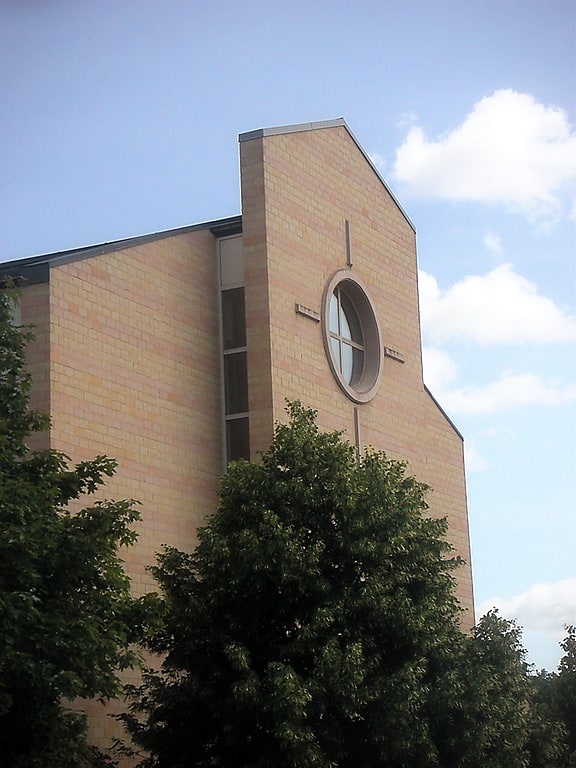
Church in Uppsala, Sweden. The Löten Church is a church located at Heidenstam Square, in Uppsala, Sweden, and is a district church of Gamla Uppsala Parish. Lötenkyrkan is one of forty partner churches that exist between the Church of Sweden and the Swedish Evangelical Mission. Hans Lindholm serves as the pastor of the Church.[23]
Address: Heidenstamsgatan 71, 754 27 Uppsala
Universitetshuset
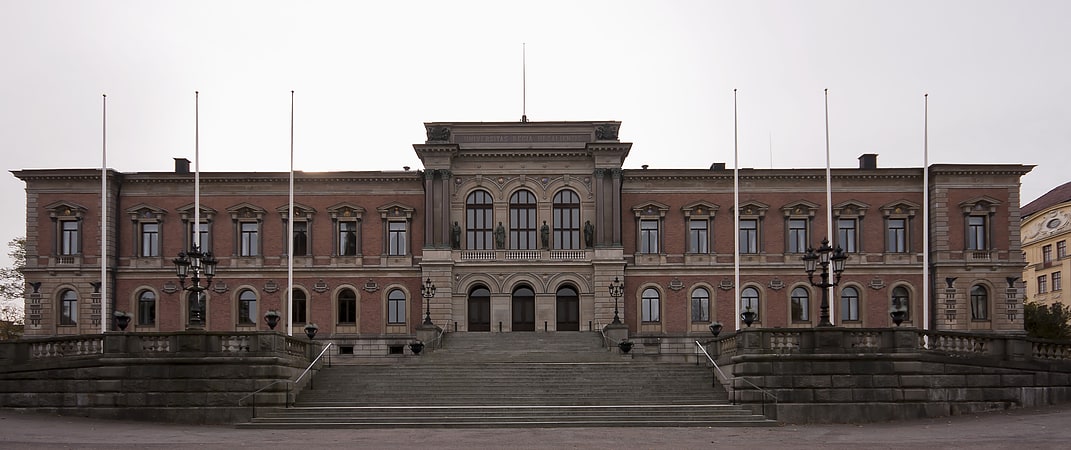
University Hall or the University Main Building is the main building of Uppsala University in Uppsala, Sweden. The building is situated in University Park close to Uppsala Cathedral. It was designed in Italian renaissance Beaux-Arts style by architect Herman Teodor Holmgren and completed in 1887.
The building should not be confused with Carolina Rediviva, which is the Uppsala University Library building, or Gustavianum, the previous main building, which today is a museum.[24]
Address: 3 Biskopsgatan, 753 10 Uppsala
Upsala-Lenna Jernväg
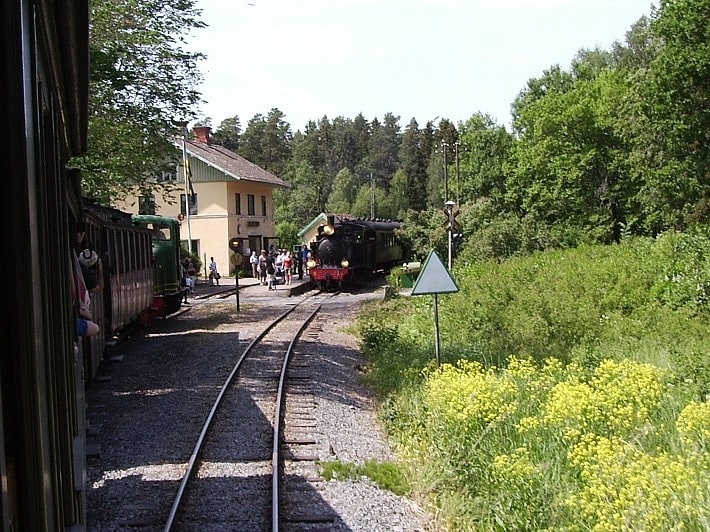
Also known as: Upsala–Lenna Jernväg
Train station in Uppsala, Sweden. Upsala-Lenna Järnväg is a narrow-gauge heritage railway in Uppsala County, Sweden. It is 33 km long and is a part of the once extensive Roslagen network. The gauge is the 891 mm, unique to Sweden. The railway is run by the SRJmf society.[25]
Uppsala Mosque

Also known as: Uppsala moské
Mosque in Uppsala, Sweden. The Uppsala Mosque is a small but very frequented mosque located in the Kvarngärdet neighbourhood of Uppsala in Sweden. At the time of construction, it was mistakenly claimed to be the northernmost mosque in the world. It is still the northernmost mosque in Sweden.
There is another small mosque in Uppsala, located at Bandstolsvägen 28, near Gottsunda centrum. However, Friday Prayer doesn't get offered at this mosque.[26]
Address: Sportfältsvägen 1, Uppsala
Biotopia
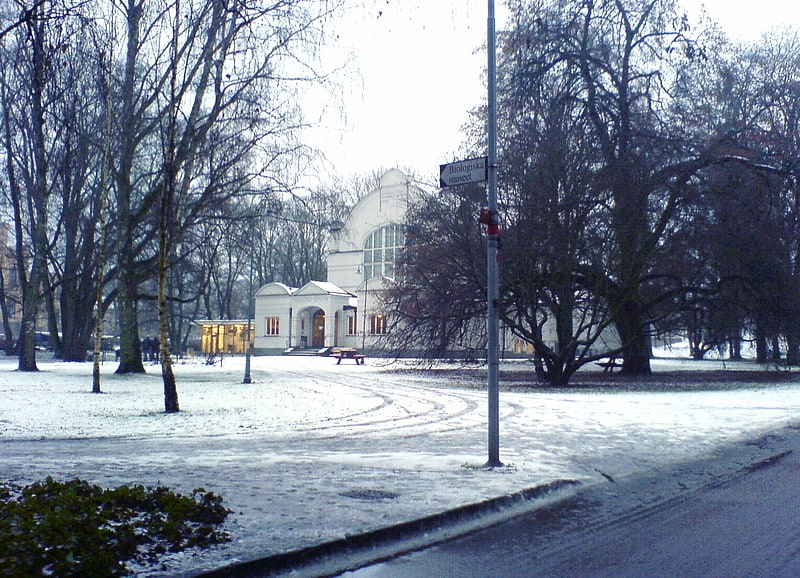
The Biological Museum of Uppsala is located in Vasaparken next to Vasahuset and Ekonomikum, next to Katedralskolan.
Address: Kyrkogårdsgatan 35, 753 13 Uppsala
Disagården
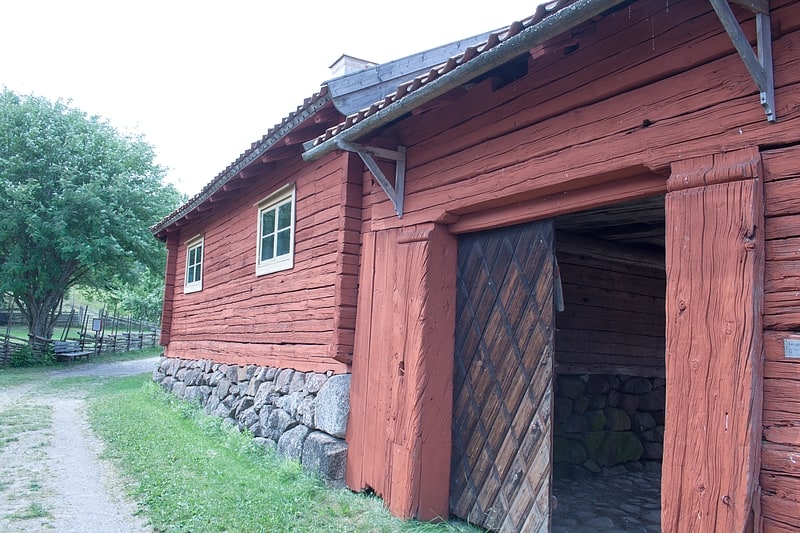
Disagården is an open-air museum in Gamla Uppsala outside Uppsala in Uppsala County.
The complex belongs to Upplandsmuseet and consists of houses from the 16th, 17th, 18th and 19th centuries, which together give a picture of what an Upland village might have looked like in the mid-19th century. The buildings originally come from different parts of Uppland and have been moved to Disagården. The open-air museum is open during the summer months.
The Pump House

The Pump House is an information and meeting place with an exhibition and education for schoolchildren. The building is located at Islandsbron next to Fyrisån in Uppsala. The building was Uppsala's waterworks for almost 100 years, and then became a municipal museum.
Modernised in 2016-2017, the Pump House is now not only a historic building, but also houses a new interactive exhibition where visitors can learn more about water, waste and the history of water in Uppsala.
Address: Munkgatan 2, Uppsala
Södermanlands-Nerikes nation

Södermanlands-Nerikes Nation is one of the 13 student nations of Uppsala University. The nation claims its founding to be in 1548 when the original Södermanlands nation was founded, this nation merged with the Nerikes nation in 1805 to form the current nation. Though at the turn of the 20th century its numbers were as low as 100 members, there are currently around 5,000 students as members.
Snerikes is unique amongst student nations in being not entirely open to all students. Swedes must be from or have close family relations to the Snerikes catchment area to join. This requirement is waived for foreign students; Snerikes is in fact a popular nation for ERASMUS students.[27]
Address: S:t Olofsgatan 16, 753 12 Uppsala
Uppland Runic Inscription 489
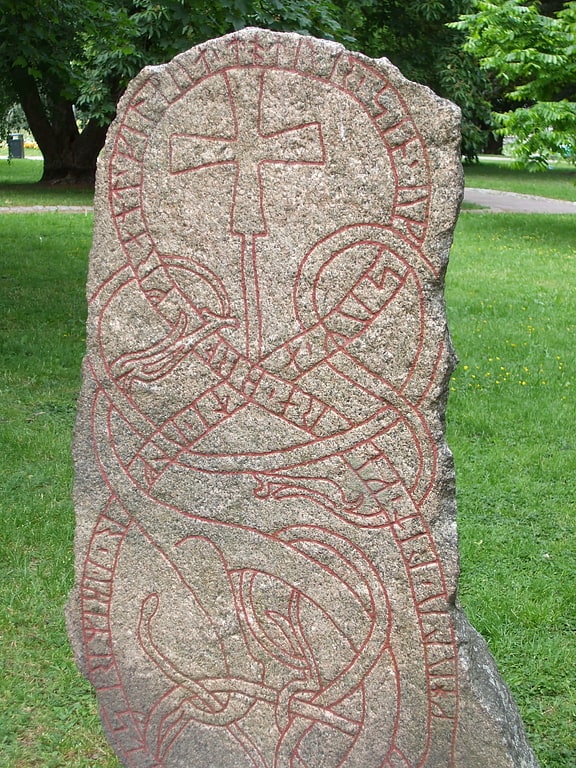
Also known as: Upplands runinskrifter 489
This Viking Age runestone, listed under Rundata as runic inscription U 489, was originally located in Morby, Uppland, Sweden, and is a memorial to a woman.[28]
Uppsala old cemetery
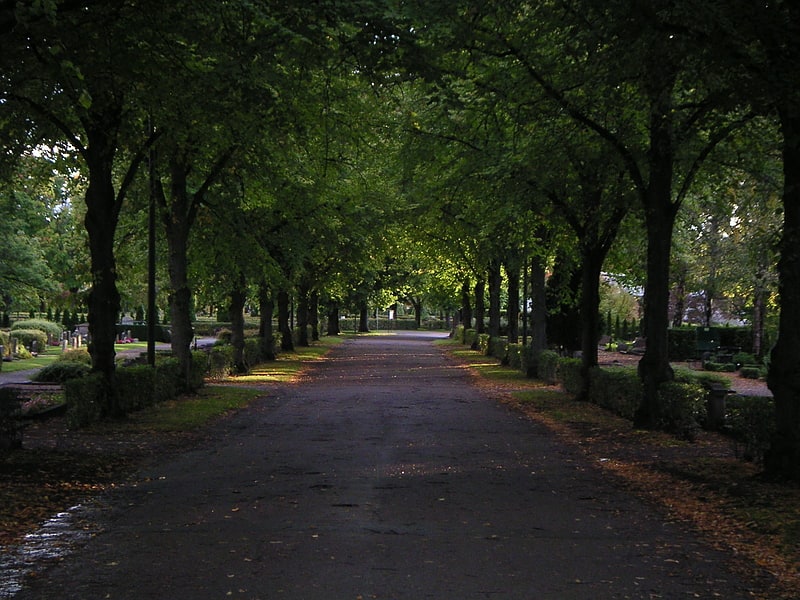
Also known as: Uppsala gamla kyrkogård
Cemetery in Uppsala, Sweden. Uppsala old cemetery is a cemetery in Uppsala, Sweden.[29]
SLU
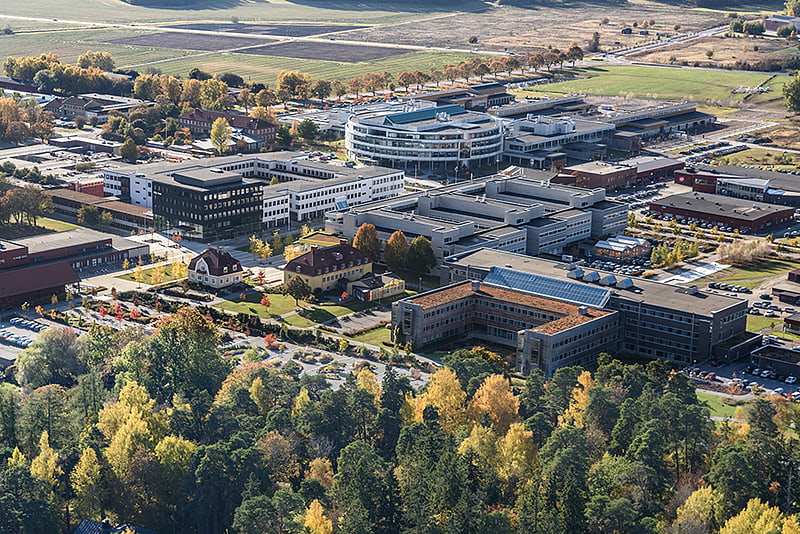
Also known as: Sveriges lantbruksuniversitet
University in Uppsala, Sweden. The Swedish University of Agricultural Sciences, or Swedish Agricultural University is a university in Sweden. Although its head office is located in Ultuna, Uppsala, the university has several campuses in different parts of Sweden, the other main facilities being Alnarp in Lomma Municipality, Skara, and Umeå. Unlike other state-owned universities in Sweden, it is funded through the budget for the Ministry for Rural Affairs. The University was co-founder of the Euroleague for Life Sciences which was established in 2001.
The university has four faculties: Faculty of Landscape Planning, Horticulture and Agricultural Sciences, Faculty of Natural Resources and Agriculture Sciences, Faculty of Veterinary Medicine and Animal Science and Faculty of Forest Sciences. SLU had in 2020 3155 full-time staff, 4216 full-time students, 559 research students and 191 professors.[30]
Address: Box 7070, Uppsala
Uppland Runic Inscription 933
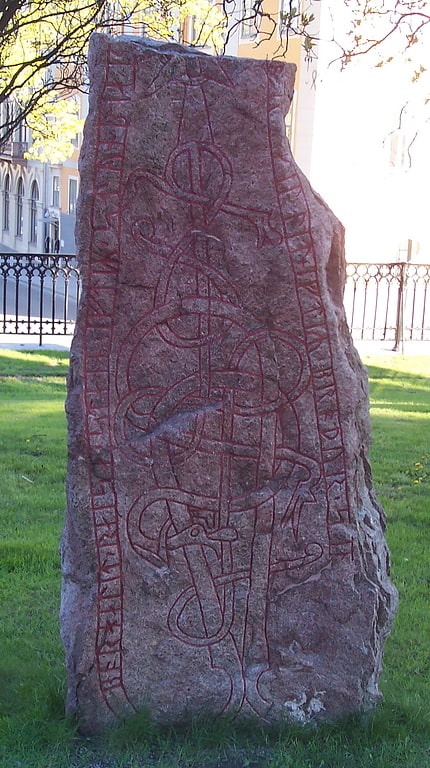
Also known as: Upplands runinskrifter 933
Uppland Runic Inscription 933 or U 933 is the Rundata catalog number for a granite Viking Age memorial runestone located at the Uppsala Cathedral, which is in the center of Uppsala, Sweden.[31]
Uppland Runic Inscription Fv1976;104
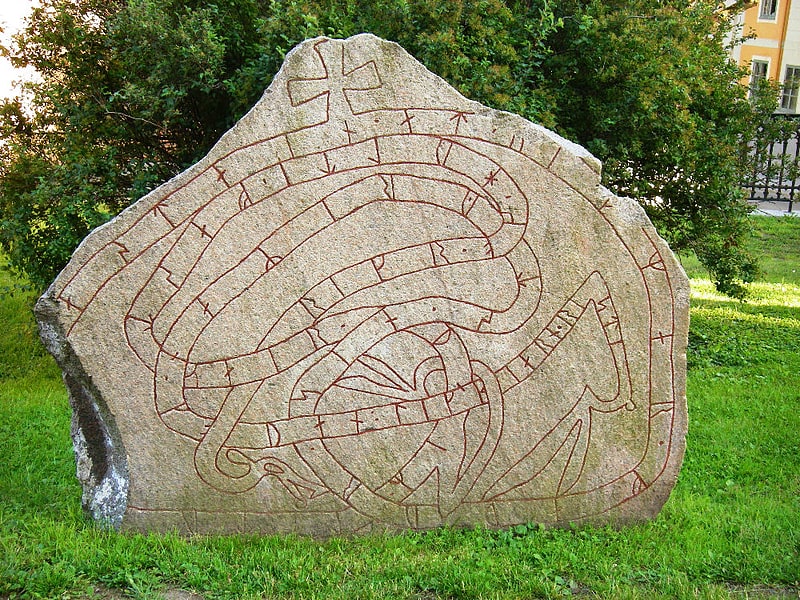
Also known as: Upplands runinskrifter Fv1976;104
This runic inscription, designated as U Fv1976;104 in the Rundata catalog, is on a Viking Age memorial runestone that is located at the Uppsala Cathedral, Uppland, Sweden.[32]